A comparative study of incidence, mortality and disability adjusted life years (DALYs) for leading cancers in BRICS countries
Anita Nath, Ruchita Taneja, Yamini Saraswathi Thadi, Gokul Sarveswaran and Prashant Mathur
ICMR-National Centre for Disease Informatics and Research, Nirmal Bhawan, Kannamangala, Bengaluru 562110, Karnataka, India
Abstract
Background: While cancer stands as a prominent global contributor to mortality, the BRICS countries, which contribute a considerable proportion of the world’s economy, also account for a substantial proportion of global cancer-related deaths. The study aims to compile data on the incidence, mortality and disability-adjusted life years (DALYs) of leading cancers in BRICS countries to assess any variations in these parameters.
Methods: Indicators such as the age-standardised incidence rate (ASIR) and age-standardised mortality rate (ASMR) were abstracted from GLOBOCAN 2022. Global Burden of Disease 2019 provided an overview of DALYs. Additionally, ‘Cancer Tomorrow’ provided projections for future cancer rates up to 2050.
Results: The findings revealed that Russia had the highest ASIR for both sexes. Among males, leading cancer sites included prostate, lung and colorectum, while India stood out with lip and oral cavity cancer as the primary site. Breast cancer dominated among females in all BRICS countries, except China, where lung cancer took precedence. South Africa recorded the highest ASMR for both sexes, with Russia leading among males and South Africa among females. Lung cancer has been the leading cause of death in all countries except India, where breast cancer leads. Trachea, bronchus and lung cancers contributed the most to DALYs, except in India, where breast cancer prevailed. South Africa and India are anticipated to have the highest increase in new cancer cases and deaths in future.
Conclusion: Breast and lung cancers accounted for the highest incidence, mortality and DALYs in females and males, respectively. Although the BRICS countries anticipate sustained economic growth and have viable cancer control plans, it is essential to investigate cancer risk factors and health systems influencing cancer incidence and outcomes.
Keywords: cancer, incidence, mortality, disability adjusted life years, BRICS
Correspondence to: Anita Nath
Email: anita.nath@icmr.gov.in
Published: 19/09/2024
Received: 27/04/2024
Publication costs for this article were supported by ecancer (UK Charity number 1176307).
Copyright: © the authors; licensee ecancermedicalscience. This is an Open Access article distributed under the terms of the Creative Commons Attribution License (http://creativecommons.org/licenses/by/4.0), which permits unrestricted use, distribution, and reproduction in any medium, provided the original work is properly cited.
Introduction
Cancer stands as a prominent global contributor to mortality, responsible for almost 10 million deaths in 2020, amounting to approximately one-sixth of all deaths, among which cancers of the lung, colon and rectum, liver, stomach and breast accounted for the highest number of deaths [1].
Based on 2019 estimates by the World Health Organisation (WHO), cancer emerges as the first or second leading cause of mortality under the age of 70 in 112 out of 183 countries while securing the third or fourth position in an additional 23 countries [2]. An estimated increase of 26.3%, 20.9% and 16.0% in cancer incidence, mortality and disability-adjusted life years (DALYs) has been observed between 2010 and 2019, with the highest increase in low and middle-income countries [3].
The occurrence of cancer and its outcomes is associated with socio-demographic, socio-cultural and behavioural risk factors and health systems that can differ among countries and may persist in specific geographic regions. The observed variations could also reflect disparities in the accessibility of cancer services, encompassing screening and treatment. In certain areas, this stems from a lack of infrastructure to deliver these services, while in others, the cost of cancer care, which comprises diagnosis, treatment and follow-up, renders them inaccessible to specific individuals. While densely populated and accounting for 42% of the world’s population, the BRICS nations, including Brazil, Russia, India, China and South Africa, are also experiencing swift economic changes and are expected to contribute towards a quarter of the global economy [4]. The economic changes in BRICS nations could have a considerable impact on cancer incidence, mortality and DALYs. Economic growth often enhances healthcare infrastructure, increases access to medical services and improves early cancer detection, potentially lowering mortality and DALYs. However, such growth can also exacerbate healthcare inequalities, with some groups benefiting more. Additionally, economic development can lead to lifestyle changes, such as increased consumption of tobacco, alcohol and processed foods and decreased physical activity, which may elevate cancer incidence rates.
Conversely, higher incomes and education can foster healthier lifestyles and preventive measures. Therefore, the overall effect of economic changes on cancer outcomes in BRICS nations is complex and multifaceted. The study aims to describe the incidence, mortality and DALYs of leading cancers in BRICS countries to assess any variations in these parameters. Detecting variations in cancer incidence, mortality and DALYs might signify diverse risk patterns that should inspire research into the causes, offer insights for allocating health resources and direct interventions to mitigate risks.
Material and methods
The present study analysed relevant cancer-related indicators such as incidence, mortality and DALYs that were abstracted from global resources for the BRICS countries. Data on the age-standardised incidence rate (ASIR) and age-standardised mortality rate (ASMR) indicators were abstracted from GLOBOCAN 2022, a web-based repository. It comprises worldwide cancer statistics, including estimates for the incidence and mortality of 36 cancer types in 185 countries and comprehensive data for all combined cancer sites [5]. The Global Burden of Disease 2019, which gives a keen overview of mortality and disability on a global scale, considering factors such as countries, time, age and gender, provided data on DALYs [7]. The Global Cancer Observatory-Cancer Over Time showcases global patterns in cancer-specific incidence and mortality rates [8]. The incidence information relies on well-documented data collected by one or more population-based cancer registries at either subnational or national levels. Data on ASIR for two time periods for Brazil (1993 and 2012), China (1988 and 2012) and India (1983 and 2012) was abstracted from this resource. Data on the estimated number of new cancer cases and deaths in 2022 and 2045 was abstracted from the Global Cancer Observatory-Cancer Tomorrow. ‘Cancer Tomorrow’ offers a range of data visualisation tools for forecasting future cancer incidence and mortality rates in a specified country or region [9]. The predictions extend from the current estimates in 2022 to the year 2050, utilising projections for the absolute numbers, incidence, mortality and prevalence of 36 specific cancer types and overall cancer rates for both sexes-males and females and age groups 0–85+ years. These projections cover 185 countries or territories worldwide in 2022, categorised by sex and age group, as part of the comprehensive GLOBOCAN project. The data were abstracted and entered using Microsoft Excel and analysed using descriptive statistics.
Ethics approval
The study was approved by the Institutional Ethics Committee NCDIR/IEC/3068/2023.
Results
ASIR of all cancers combined
The ASIR of all cancers combined among males, females and both sexes is shown in Figure 1. ASIR was highest in Russia in both the sexes combined (248.1 per 100,000), males (288.5 per 100,000) and females (230.8 per 100,000), followed by Brazil (214.4 per 100,000) and South Africa (203.4 per 100,000) for both sexes. Cervical cancer ranked as the second leading site of cancer among females in India and South Africa. A comparison of the ASIR of three countries at different periods, as shown in Figure 2, noted a decline in ASIR among cancer in males in China over nearly 25 years (261.3 per 100,000 in 1988 and 212.7 per 100,000 in 2012. There has been a remarkable increase in ASIR among males in Brazil (192.1 per 100,000 in 1993 and 271.0 per 100,000 in 2012). The rise in ASIR has also been noted in males in India and females in Brazil, India and China.
Leading incident cancer sites
The commonest top three leading cancer sites among males comprised prostate, lung and colorectum. India is the only nation where cancer of the lip and oral cavity constituted the top leading site. Breast cancer accounted for the highest proportion of cases among females in all the countries except China, where lung cancer ranked as the first leading site. Cervical cancer ranked as the second leading site of cancer among females in India and South Africa.
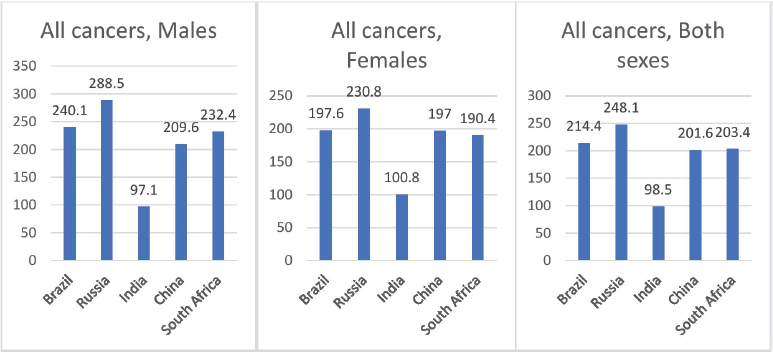
Figure 1. Age standardised incidence rate of all cancers in BRICS countries.
Table 1. Absolute percentage all cases in BRICS countries 2022 according to sex.
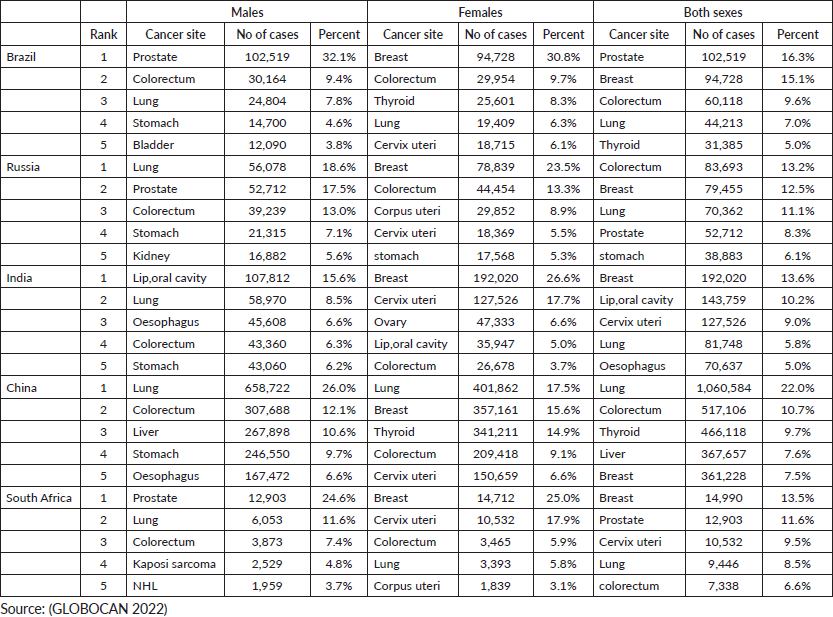
Age standardised mortality rate
The highest ASMR due to all cancers was observed in South Africa for both sexes (122.5 per 100,000), in Russia for males (153.0 per 100,00) and among females in South Africa (110.6 per 100,000), as shown in Figure 3.
Top five leading cancer sites accounting for deaths in both sexes
The leading cancer sites that contributed to cancer deaths are shown in Table 2. The highest number of deaths were due to lung cancer in all countries except India, where the leading cause of death was due to breast cancer.
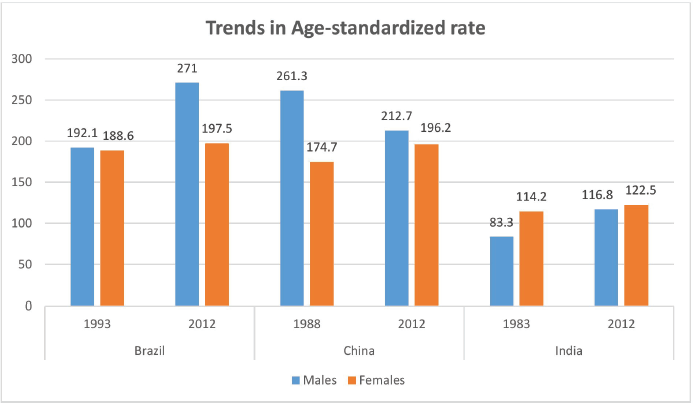
Figure 2. Comparison of standardised incidence rate at two different periods for Brazil, China and India.
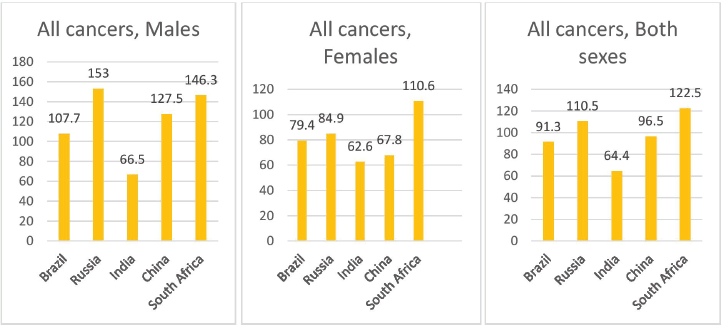
Figure 3. Age standardised mortality rate of all cancers in BRICS countries.
Table 2. Top five leading cancer sites accounting for deaths in both sexes in BRICS countries.
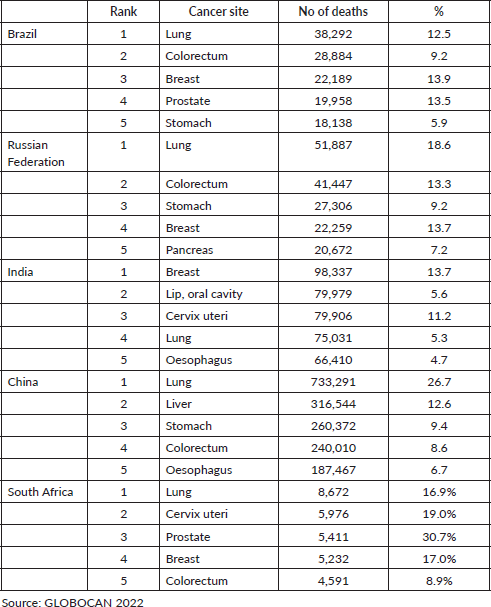
DALYs, leading cancers
Cancers of the trachea, bronchus and lung contributed to the highest DALYs in all the BRICS countries, except India, where breast cancer accounted for the highest DALYs 193.96 (150.3–246.24) as presented in Table 3.
Table 3. DALY of leading cancers, BRICS countries (all ages, 2019).
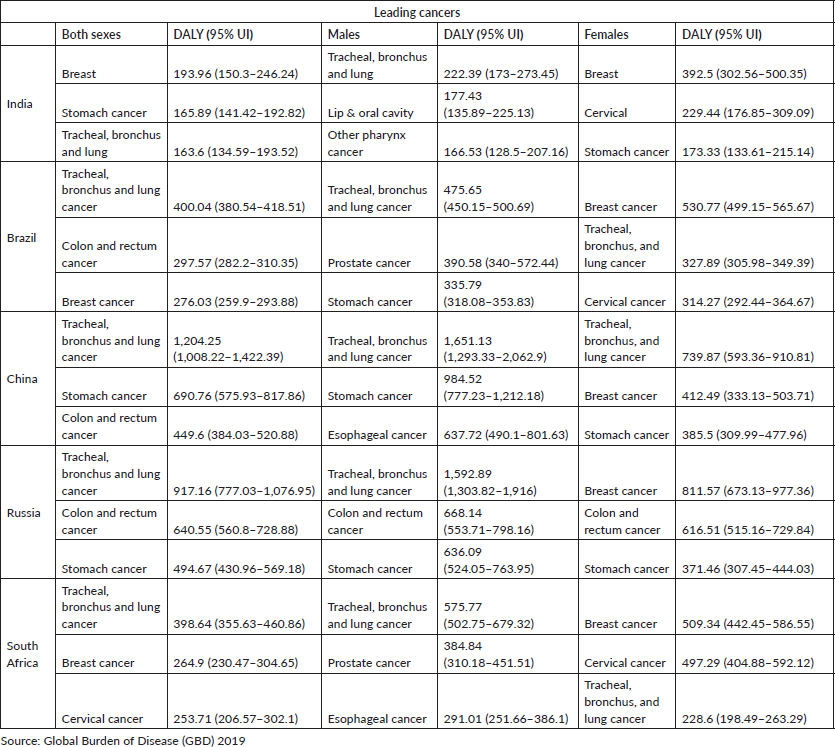
Estimated number of new cases and deaths from 2022 to 2045
The estimated number of new cases and deaths in 2022 and 2045 are represented in Figures 4 and 5, illustrating that South Africa and India are expected to witness the highest increase in new cancer cases and deaths as shown in Table 4.
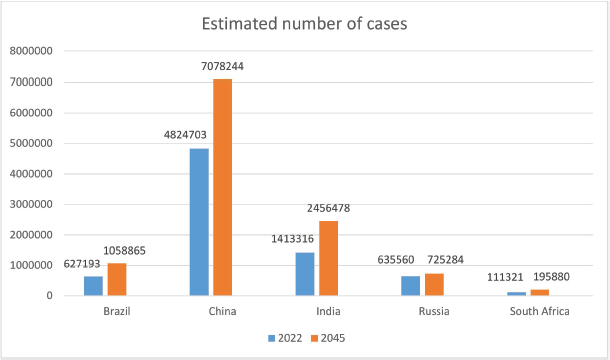
Figure 4. Estimated number of cases (0–85 years) from 2022 to 2045, in both sexes.

Figure 5. Estimated number of deaths (0–85 years) from 2022 to 2045 in both sexes.
Table 4. Percentage change in number of new cancer cases and deaths in 2022 and 2045.
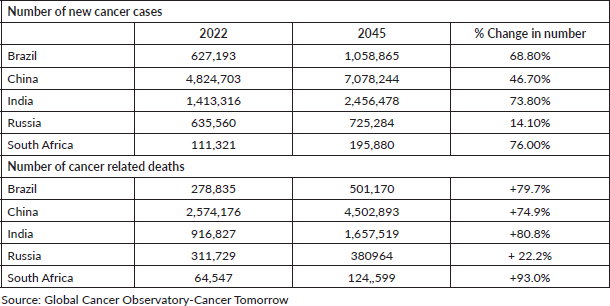
Data sharing statement
The data that support the findings of this study are available in https://www.who.int/data/gho/indicator-metadata-registry/imr-details/78; https://gco.iarc.fr/overtime; https://gco.iarc.fr/tomorrow;
Discussion
This paper comprehensively analysed cancer incidence, mortality and DALYs in the BRICS nations. The findings also reflect upon the economic transition that is being experienced by these countries. The age-standardised cancer incidence ASIR was highest in Russia compared to other BRICS countries. The variations in the ASIR could be attributed to a nation’s development and socio-demographic profile. A strong correlation between the human development index (HDI) and cancer incidence has been observed; national incidence rates rise rapidly as HDI levels increase [10]. Russia has the highest HDI of 0.821 among all the five countries [11]. India recorded the lowest cancer incidence, which could be explained by the higher proportion (33%) of young population of less than 15 years [12]. On the contrary, Russia belongs to demographically old countries wherein the proportion of persons over 65 is 15% [13].
Compared to other nations, India was distinct in terms of reporting a high incidence of lip and oral cavity cancer. Oral cancer holds considerable public health significance in India. Earlier studies conducted in India have conveyed that the country has the highest occurrence of oral cancer, with smoked and smokeless tobacco forms having been identified as a leading cause and smokeless tobacco contributes to a higher risk of cancer in women [14]. From an economic perspective, low socioeconomic status can increase the risk of oral cancer, similar to the effect of lifestyle risk factors [15]. Breast cancer constituted one of the top cancer sites in terms of new case numbers in females in all five countries and DALYs in four countries, which socioeconomic progress can explain. A prior review indicated that BRICS countries accounted for 33.6% of new breast cancer cases worldwide and 36.9% of global breast cancer deaths. Additionally, these countries experienced a significant upward trend in breast cancer incidence [16]. Stomach cancers were among the top five leading sites among males in all BRICS countries except South Africa. China holds the highest number of stomach cancer cases, totalling 478,000, constituting 43.9% of the global incidence [17]. The high absolute numbers of cases of Kaposi sarcoma and Non-Hodgkins Lymphoma (NHL) in South Africa are reflective of the high incidence of HIV in the country [18]. Concerning changes in ASIR between the two-time points, it is interesting to note the rise in ASIR in both sexes in Brazil and India and females in China, except for Chinese males, where a decline was observed in 2012 compared to 1988. The ASIR in Chinese men has demonstrated a consistent and stable pattern over the preceding decades [19].
The age-standardised cancer mortality rate was highest in both genders combined and females in South Africa compared to other BRICS countries. Among all cancers, lung cancer accounted for the most increased mortality in China, Brazil, Russia and South Africa. The incidence and mortality rates of lung cancer are highest in economically developed countries where tobacco smoking was most prevalent several decades ago. However, these rates have mostly reached their peak and are now on the decline [20]. Cancer deaths significantly contribute to overall productivity loss. A study by Pearce et al [21] revealed that BRICS nations account for 42% of global cancer-related deaths. China experienced the highest total productivity loss at $28 billion, while South Africa incurred the highest cost per cancer death at $101,000. Our analysis also shows the sharp increase in cancer cases and deaths between 2022 and 2045 in India and South Africa. Sathishkumar et al [22] reported a 12.8% increase in the incidence of cancer cases in India in 2025 compared to 2020 and that cancer incidence is continuing to rise. The projected growth in cancer case numbers can be linked to the upsurge in life expectancy at birth, a trend observed across all BRICS countries from 2000 to 2022 [12].
The study underscores the significant role of BRICS countries in global cancer-related morbidity mortality and highlights the impact of economic changes on cancer incidence and outcomes in these nations. The progressive privatisation of healthcare has resulted in increased inequality, fragmentation of public health services and elevated levels of out-of-pocket spending – standard features observed in the BRICS countries. Our research highlights that policies promoting lifestyle changes to reduce cancer risk can positively impact the economies of BRICS countries. Integrating tobacco control, vaccination programs and cancer screening with access to proper treatment could substantially benefit public health and economic performance. The findings also highlight the need to strengthen cancer surveillance through cancer registration. While each BRICS country has established cancer registries, they face common challenges such as data completeness and resource limitations. Although the BRICS countries anticipate sustained economic growth and have viable cancer control plans, it is essential to investigate cancer risk factors and health systems influencing cancer incidence and outcomes. In light of these considerations, there is both a necessity and an opportunity for the BRICS nations to collaborate and learn from each other, thereby enhancing the overall progress of sustainable development.
Conflicts of interest
None to declare.
Funding
No funding was received to conduct this analysis.
References
1. Ferlay J, Colombet M, and Soerjomataram I, et al (2021) Cancer statistics for the year 2020: an overview Int J Cancer 149(4) 778–789 https://doi.org/10.1002/ijc.33588
2. World Health Organization (2020) Global Health Estimates 2020: Deaths by Cause, Age, Sex, by Country and by Region, 2000–2019 (Geneva: World Health Organization)
3. Kocarnik JM, Compton K, and Dean FE, et al (2022) Cancer incidence, mortality, years of life lost, years lived with disability, and disability-adjusted life years for 29 cancer groups from 2010 to 2019: a systematic analysis for the global burden of disease study 2019 JAMA Oncol 8 420–444 https://doi.org/10.1001/jamaoncol.2021.6987
4. Singh SP and Memory D (2013) The BRICS and the New World Order: A Beginner’s Guide (Brazil: Centre for International Trade, Economics and Environment, South African Institute of International Affairs)
5. Ferlay J, Ervik M, and Lam F, et al (2024) Global Cancer Observatory: Cancer Today (Lyon: International Agency for Research on Cancer) [https://gco.iarc.who.int/today] Date accessed: 08/02/24
6. Ahmad O, Boschi Pinto C, and Lopez A, et al (2001) Age Standardization of Rates: A New WHO Standard GPE Discussion Paper Series, EIP/GPE/EBD (Geneva: World Health Organization) No. 31
7. Global Burden of Disease [
8. Ervik M, Lam F, and Laversanne M, et al (2021) Global Cancer Observatory: Cancer Over Time (Lyon: International Agency for Research on Cancer) [https://gco.iarc.fr/overtime] Date accessed: 07/02/24
9. Ferlay J, Laversanne M, and Ervik M, et al (2024) Global Cancer Observatory: Cancer Tomorrow (Lyon: International Agency for Research on Cancer) [https://gco.iarc.fr/tomorrow] Date accessed: 10/02/24
10. Vaccarella S, Lortet-Tieulent J, and Saracci R et al (2019) Reducing social inequalities in cancer: evidence and priorities for research IARC Scientific Publications, No. 168 (Lyon: International Agency for Research on Cancer)
11. Human Development Reports [https://hdr.undp.org/data-center/country-insights#/ranks] Date accessed: 03/07/24
12. Population Reference Bureau The BRIC Countries https://www.prb.org/resources/the-bric-countries/ Date accessed: 04/02/24
13. Dobrokhleb VG (2021) When society ages Her Russ Acad Sci 91 587–592 https://doi.org/10.1134/S1019331621050026 PMID: 34744398 PMCID: 8562025
14. Gupta S, Gupta R, and Sinha DN, et al (2018) Relationship between type of smokeless tobacco and risk of cancer: a systematic review Indian J Med Res Suppl 148 56–76 https://doi.org/10.4103/ijmr.IJMR_2023_17
15. Conway DI, Petticrew M, and Marlborough H, et al (2008) Socioeconomic inequalities and oral cancer risk: a systematic review and meta-analysis of case-control studies Int J Cancer 122(12) 2811–2819 https://doi.org/10.1002/ijc.23430 PMID: 18351646
16. Mubarik S, Luo L, and Iqbal M, et al (2023) More recent insights into the breast cancer burden across BRICS-plus: health consequences in key nations with emerging economies using the global burden of disease study 2019 Front Oncol 13 1100300 https://doi.org/10.3389/fonc.2023.1100300
17. Sung H, Ferlay J, and Siegel RL, et al (2021) Global cancer statistics 2020: GLOBOCAN estimates of incidence and mortality worldwide for 36 cancers in 185 countries CA Cancer J Clin 71 209–249 https://doi.org/10.3322/caac.21660 PMID: 33538338
18. Zuma K, Simbayi L, and Zungu N, et al (2022) The HIV epidemic in South Africa: key findings from 2017 national population-based survey Int J Environ Res Public Health 19 8125 https://doi.org/10.3390/ijerph19138125 PMID: 35805784 PMCID: 9265818
19. Maomao C, He L, and Dianqin S, et al (2022) Current cancer burden in China: epidemiology, etiology, and prevention Cancer Biol Med 19 1121–1138 [10.20892/j.issn.2095-3941.2022.0231] https://doi.org/10.20892/j.issn.2095-3941.2022.0231 PMID: 36069534 PMCID: 9425189
20. Leiter A, Veluswamy RR, and Wisnivesky JP (2023) The global burden of lung cancer: current status and future trends Nat Rev Clin Oncol 20 624–639 https://doi.org/10.1038/s41571-023-00798-3 PMID: 37479810
21. Pearce A, Sharp L, and Hanly P, et al (2018) Productivity losses due to premature mortality from cancer in Brazil, Russia, India, China, and South Africa (BRICS): a population-based comparison Cancer Epidemiol 53 27–34 https://doi.org/10.1016/j.canep.2017.12.013 PMID: 29353153
22. Sathishkumar K, Chaturvedi M, and Das P, et al (2022) Cancer incidence estimates for 2022 and projection for 2025: result from National Cancer Registry Programme, India Indian J Med Res 156(4–5) 598–607 [https://doi.org/10.4103/ijmr.ijmr_1821_22] PMID: 36510887 PMCID: 10231735
Supplementary text
Definitions
- ASIR: The ASIR is a consolidated rate that reflects what would have been observed in a population with the age distribution of a specified reference population, commonly referred to as the standard population, based on the schedule of age-specific rates [6].
- ASMR: The ASMR is a calculated average of age-specific mortality rates per 100,000 individuals, utilising weights determined by the proportions of individuals in the respective age groups of the WHO standard population [7].
- DALYs attributed to a disease or health condition result from the combination of Years of Life Lost to premature mortality (YLLs) and Years Lived with Disability (YLDs) caused by a said disease or health condition within a population.






